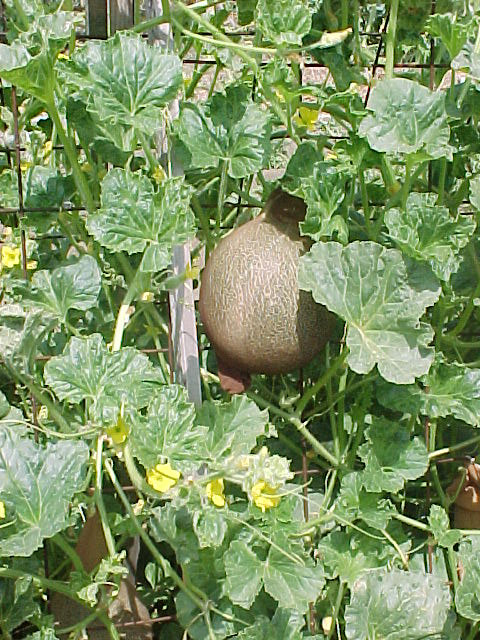 Huell Howser's favorite repurposed household tool -- my using old pantyhose tied to a trellis to hold melons up off of the soil and away from pests.
Huell Howser's favorite repurposed household tool -- my using old pantyhose tied to a trellis to hold melons up off of the soil and away from pests. Lift melons off the soil surface get them away from moist soil and crawling pests. Boards, cans, or plastic baskets from strawberries or cherry tomatoes serve well.
When Huell Howser came to my garden (see https://blogs.chapman.edu/huell-howser-archives/2004/09/04/californias-green-103-green-gardener/), his favorite repurposed household tool was my using old pantyhose tied to trellises to hold melons up off of the soil -- see photo at left. The mesh of the pantyhose allows the melon (or squash or watermelon or whatever vine fruit you're using it on) to grow unimpeded while protecting it from pests.
Stop watering melon plants the week before they'll be ripe to allow the sweetness to concentrate and to minimize fruit-cracking problems.
Fertilize tasseling corn and other vegetables that are still setting -- beans, cucumbers, eggplants, tomatoes, etc.--for increased yields. Plants appreciate this extra boost in food to use immediately in maturing their fruits. But during our extra-hot weather, be sure to water the plants well first so the fertilizer won't "burn" the roots.
Continue to keep vine vegetables (especially beans, cucumbers, squash, and tomatoes) picked, whether or not you will use the harvest that day. If many fruits are allowed to overmature on the plant, they’ll “think” they’ve accomplished their reproductive duty and won’t put out any more blossoms for more fruit.
But if you have kept plants well-picked and fertilized, and fruit set has stopped, suspect hot weather. Fruit set will begin again about ten to fourteen days after the temperature stays below 85 to 90 degrees.
Harvest fruits and vegetables as early in the day as possible, especially if they are not to be eaten that day or will be refrigerated. Research at the University of California, Davis, has found that the six hours before sunrise is the best time to harvest because it’s the coolest. As soon as the sun hits the fruits or vegetables, the pulp temperature begins to rise, and even shading them will not delay the temperature rise for long. Each five degrees lower temperature when the fruit is picked will extend shelf-life for another three days.
Tomatoes, in particular, develop more chilling injury -- that telltale graininess and mushiness -- when they are cooled after being harvested when thoroughly warm. That’s why you shouldn’t refrigerate tomatoes!
As vine crops reach the tops of their trellises, pinch off the lead vine; the side shoots will take over the major growth and food production.
Pinch off the last blossoms of eggplants, peppers, melons, squashes, and tomatoes. Plant energy will then be spent maturing fruit that's already set, instead of setting more fruit that won't ripen sufficiently before fall cold (yes, it's coming!).
Feed and water bramble fruits and strawberries. The size of next summer's fruit is determined this month and next--the more fertilizer and irrigation, the bigger the berries will be next spring. Propagate bramble fruits by bending the cane tips to the soil surface and burying one or two nodes an inch or so deep.
Remove tree suckers and watersprouts -- the long shoots that grow straight up from the trunk base (sucker) or a branch (watersprout).
Keep tree trunks -- especially of young trees -- painted with light-color, matte-finish, indoor latex paint to protect them from sunscald. This will continue into the winter for deciduous trees, as well.
Stop feeding trees later this month, or the resulting tender new growth will be damaged by winter frosts. The gradually cooling weather and lack of additional nitrogen fertilizer during September, October, and early November will help harden exuberant summer growth to withstand winter's cold.
Feed azaleas, camellias, and rhododendrons an acid fertilizer for the last time this year, to help them set buds for early spring bloom. Continue feeding begonias, fuchsias, and summer annuals. Container plants and water-lovers such as baby's tears, coleus, and fuchsias may need daily irrigation during hot weather. Feed mums until their buds begin to show color and open.
Increase bloom size of chrysanthemums and dahlias by removing half of the new buds.
Prolong fuchsia blooms by picking off the faded flowers, yellowed leaves, and fruits. Trim back stems to force side branching and flowering, and fertilize and water them well.
Prune summer-blooming shrubs when they've finished flowering.
Shape hedges for the last time this season.
Continue gently shaping roses after pruning suckers, unwanted branches, and spent blooms; cultivate manure, bonemeal, and cottonseed meal into the top three inches of soil, and water deeply.

 RSS Feed
RSS Feed